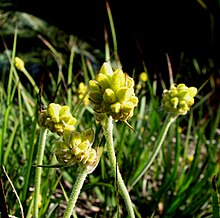en
names in breadcrumbs


Conostylis is a genus of perennial herbs in the Haemodoraceae family, commonly known as cone flowers. All species are endemic to the south west of Western Australia.
The genus is the most speciose of the Haemodoraceae family, and one of six genera which only occur in the Southwest Australia bioregion; they are closely related to the well known kangaroo paws, species of Anigozanthos and Macropidia.[3]
Conostylis was described by Robert Brown, published in his Prodromus of Australian flora in 1810. No type species was provided by the author.[1] The genus name Conostylis is derived from Ancient Greek terms for 'cone' and 'column, style', a reference to the conical shape of the style's tip.[4]
They have leathery, strap-like leaves which arise from the base of the plant, sometimes from underground rhizomes. Flowers which usually occur in clusters (sometimes singly) on stalks which emerge from the bases of the leaves.[5] Individual flowers have a short stalk with and six tepals which are either cream, yellow, orange or purple. The tepals join to form a short tube at the base with six similar stamens attached at the top of the tube.[4]
The described species of Conostylis include:[4]
 Conostylis aculeata
Conostylis aculeata Conostylis is a genus of perennial herbs in the Haemodoraceae family, commonly known as cone flowers. All species are endemic to the south west of Western Australia.
Conostylis es un género de plantas de la familia Haemodoraceae. Comprende 73 especies descritas y de estas, solo 45 aceptadas.[2][3]
El género fue descrito por Robert Brown y publicado en Prodromus Florae Novae Hollandiae 300. 1810.[4] La especie tipo no ha sido designada,
A continuación se brinda un listado de las especies del género Conostylis aceptadas hasta julio de 2014, ordenadas alfabéticamente. Para cada una se indica el nombre binomial seguido del autor, abreviado según las convenciones y usos.
Conostylis es un género de plantas de la familia Haemodoraceae. Comprende 73 especies descritas y de estas, solo 45 aceptadas.
Conostylis est un genre de plante de la famille des Haemodoraceae endémique au sud-ouest de l'Australie-Occidentale.
Selon World Checklist of Selected Plant Families (WCSP) (19 Jul 2010)[2] :
Conostylis est un genre de plante de la famille des Haemodoraceae endémique au sud-ouest de l'Australie-Occidentale.
Conostylis é um género botânico pertencente à família Haemodoraceae[1].
Conostylis é um género botânico pertencente à família Haemodoraceae.
«Conostylis — World Flora Online». www.worldfloraonline.org. Consultado em 19 de agosto de 2020Conostylis là một chi thực vật có hoa thân thảo trong họ Haemodoraceae.[1]
Các loài trong chi này là đặc hữu Tây Australia.
Conostylis là một chi thực vật có hoa thân thảo trong họ Haemodoraceae.
Các loài trong chi này là đặc hữu Tây Australia.